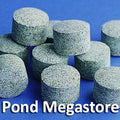




WATER HAWTHORN<br> **Cool water plant** sold as bulbs in late spring or plants in fall/winter/early spring
Water Hawthorn Plant Description:
THE WINTER WATERLILY!
Hawthorn Grows and Blooms during cooler months!
NOTE:
HAWTHORN ORDERED SEPARATE FROM OTHER PLANTS CAN SHIP DURING IN WINTER MONTHS, If you order on the same order with other plants everything will be held until spring planting time.
Water Hawthorn is a cool weather plant and does well in temperatures of 32 (below winter ice) up to 78 degrees Fahrenheit. It is a great plant and does well in most parts of the USA, especially in the north! It survives fine where air temperatures are way below 32 degrees.... If the water temperatures don't go below 32 degrees and if the water isn't frozen over--you very well may have Water Hawthorn blooming throughout the winter months! Leaves are oblong and oval in shape and emerald-green in color. The flower is small and white with tiny brown freckles and has a delicious vanilla scent when blooming! Usually sold as a dormant bulb as greenhouse temperatures are too warm for this particular plant. (Please Note; Hawthorne bulbs will perish if the water temperatures are over 90 degrees for long periods in the summer, so many places in Florida or Texas are not suitable for the Water Hawthorne Plant.) Water Hawthorn will grow and bloom in cooler temperatures when most of your other pond plants are asleep. Water Hawthorne goes dormant throughout the hot summer months and comes back in the fall when temperatures are cooler. Water Hawthorne are excellent plants for your pond!
(Latin and common names include: Aponogeton distachyos or Aponogeton distachyum, also known as waterblommetjie, Cape-pond weed, vleikos and Cape pond weed is an aquatic flowering plant.)
Plant Height Foliage of water hawthorn is at the surface of the water, blooms are an inch or two above the water's surface
Plant Width Grows to a 2 - 3 foot spread
Plant Sunlight Requirements Full sun to full shade
Moisture Needs Must be planted in water 6 inches to 30 inches deep.
Bloom Time (Any time the water 32 - 75 degrees Fahrenheit) Loves cool water!
Water Hawthorn Planting Instructions
Plant your Water Hawthorn in loam soil (topsoil mixed with sand), never potting soil as it will float right out of the pot. Plant your bulbs in the top portion of the soil (shallow) with just an inch or two of soil above the bulb, with the pointed side of the bulb pointing up, and place the pot 6 to 30 inches beneath the surface of the water. (Do not cover the soil with stones)
Should your Water Hawthorne arrive as a plant rather than a bulb, plant it the very same way!
If your Water Hawthorne arrives as a bulb, you may keep it in the crisper of your refrigerator until you are able to plant the bulbs. As of 2020 we plan to send these as live plants only unless asked for otherwise!
What Is Loam Soil?
Loam soil is a good mixture of Topsoil and Sand
If you are lucky enough to have good topsoil in your backyard, by all means, use your topsoil. All you will have to do is add fertilizer. If you are not so lucky--and your backyard is sand or heavy red or yellow clay, you can mix up a batch of loam soil.
You can create your own loam soil by mixing these two ingredients together
- 2/3 Inorganic Topsoil (Little or no organic material added)
- 1/3 Pool Filter Sand
Mix together thoroughly with a little water. Your soil should clump when squeezed. If your soil is mixed properly, it will not muddy your pond water.
You can purchase inexpensive bags of inexpensive / poor Topsoil at Lowes or Home-Depot. Good soil clumps together as a ball in your hand with only a little moisture.
Don't buy brands like Scott's or Miracle-Gro, as they will contain too much organic matter that can foul your water. Buy an unbranded bag of topsoil instead.
You can purchase Pool Filter Sand at any store that sells pool supplies.
Loam soil is well suited for all aquatic plants (except oxygenators). Oxygenators rarely need to be planted, just anchored in the substrate or in a container filled with sand or 1/8 inch pea gravel.
Sand holds little water but does allow for aeration and drainage.
Some DO's and DON'TS regarding Aquatic Planting Soil
DO NOT use potting soils ( as they are too light and will float right out of the pot). Potting Soil has organic material that will rot and foul your water!
DO NOT add too much composted material (as it is too rich in organic matter and it will ferment underwater and destroy the ecology of your pond).
DO NOT use 100% calcined clay as there is no nutritional value in calcined clay.
DO NOT add rocks, stones or pebbles to the top of your planting container as this will inhibit the growth of your plants. Plants do not grow in rocks and stones in nature!
DO NOT purchase API Aquatic Planting Media or Microbe-lift Aquatic Planting Media as these products are NOT suitable for waterlilies, lotus or most other pond plants. They are suitable for submerged grasses ONLY!







